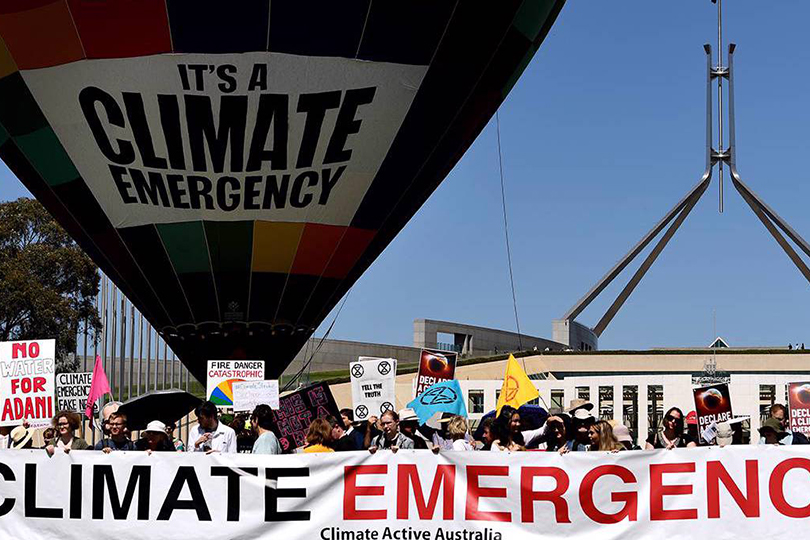Although there is a general consensus about the biggest threats facing humanity and the planet, the complex links between individual risk categories have so far received too little attention. Any realistic strategy to move toward a more sustainable future cannot treat these risks in isolation.
In addition to costing human lives, this year’s unprecedentedly severe wildfire season in Australia has destroyed an estimated 2,500 homes, killed hundreds of millions of animals, battered the economy, and placed severe pressure on the government. Coming on the heels of the country’s hottest and driest years on record, the fires highlight the depth and complexity of the global challenges we face. Likewise, the COVID-19 outbreak, which started when a new coronavirus leapt from an animal to a human in China, now threatens to disrupt economic and social life around the world.
For much of the twentieth century, we liked to think that every problem had a simple technological solution. Vaccines and antibiotics would keep us healthy, the Green Revolution would feed us, and economic growth would pay for our schools and hospitals. But today’s wildfires and epidemics demonstrate that the risks facing humanity are not so simple, and will not be managed by easy one-track solutions.
Consider the current global landscape. One million species are now at risk of extinction, the disastrous effects of climate change are becoming increasingly apparent to all, mass movements of people are becoming more common, and the world’s democracies are in the grips of partisan polarization and skepticism toward science and expertise.
The big picture can be hard to discern from any one vantage point, which is why we need a new narrative that considers the challenges of today within the complexity of the entire planetary system. To that end, the international research organization Future Earth recently published Our Future On Earth 2020, which captures our evolving prospects by connecting the dots between recent research findings and the developments we are already experiencing – from floods and water shortages to rising populism. By drawing on insights from researchers in the physical and social sciences, the report helps to explain what is driving current events and how we might move in a more sustainable direction.
The report also surveys 222 scientists across 52 countries to assess 30 categories of risk facing humanity and the planet. The top five risks identified by the respondents are extreme weather, the failure to mitigate and adapt to climate change, biodiversity loss and ecosystem collapse, food crises, and water shortages. These findings represent a meeting of minds: leaders and decision-makers who were independently surveyed by the World Economic Forum in January identified the same risks as being the most urgent.
Scientists surveyed by Future Earth also stress that they are most concerned with the linkages among the risk categories. There is every reason to expect that one global crisis could cascade into others. Heatwaves, for example, can accelerate water loss and food scarcity, just as biodiversity loss exacerbates climate change, and vice versa.
Moreover, subtle links among all 30 risks cited in the survey could have major implications for future sustainability efforts. Consider the link between political populism and the spread of digital information and communication technology (ICT). These phenomena have grown together, with populist politicians using sophisticated digital marketing techniques to reach key voter cohorts. Worse, with disinformation and propaganda flowing freely through today’s largely unregulated social-media networks, populists’simplistic message of “us vs. them” has been able to travel far and wide, and entrenched interests have been able to convince a significant share of the public to ignore the danger of climate change.
But digital ICT also has the potential to do a great deal of good, from offering a megaphone to climate activists to helping companies reduce their emissions and empowering people to monitor and protect their local ecosystems. Looking ahead, those leading the Big Tech companies need to recognize that their business models should not be focused solely on their own bottom lines. Their powerful algorithms and platforms could be used to contribute to sustainable development.
With just a decade left to achieve the United Nations Sustainable Development Goals, 2020 is a critical year. Hundreds of businesses and cities are making climate commitments and developing plans of action. At the UN Climate Change Conference this November, world leaders will try again to advance an agenda for reining in greenhouse-gas emissions. And in October, the UN Convention on Biological Diversity will set new biodiversity targets.
The Earth’s biodiversity is not just about lush Amazonian jungles and tourist-friendly African savannas. Plant and animal species are key to our own survival, not least through their contributions to medicine and agriculture. To feed a growing global population, we will need increasingly productive, diverse crop systems that can cope with ever more extreme climate conditions.
For sustainability efforts to succeed, however, we must recognize that the challenges we face are interconnected. The risks we must address cannot be managed in isolation from one another or from other political and social dynamics. Solutions to today’s health, economic, and environmental challenges demand a multidisciplinary, multilateral, systems-based approach. That will require rethinking and transforming our institutions, not to mention our own attitudes and lifestyles.
While Australia’s wildfire crisis raged far from most of us, it should be regarded globally with the same energy and focus as the coronavirus epidemic. No country, government, society, business, or individual is an island. Ultimately, we are all facing the same threats, because we are all connected to one planet, with one future.







Comments